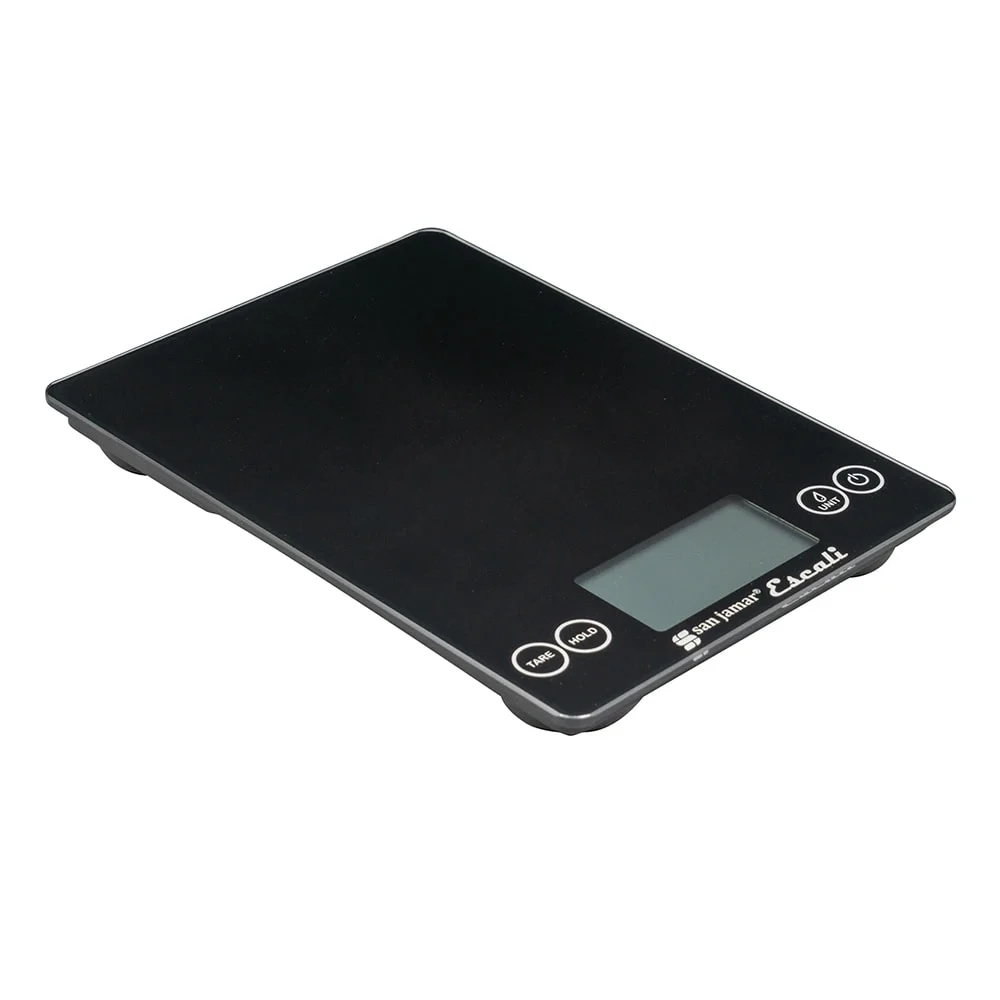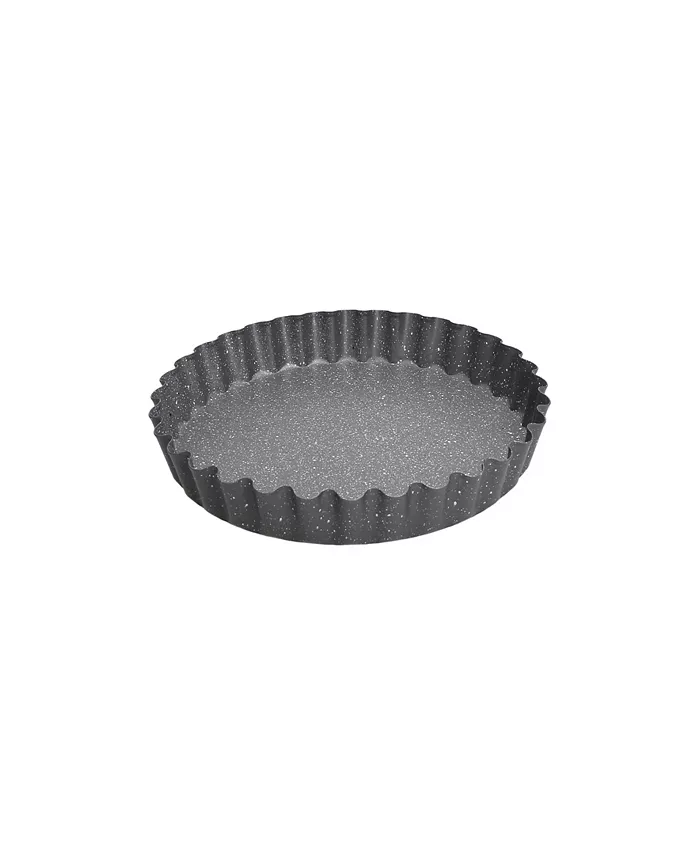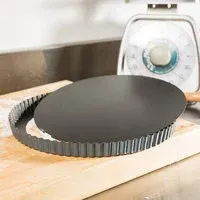With the right tart shell, pretty much anything brought home from the market can be turned into a simple but impressive main dish, a starter, or a dessert as shown in my collection of tart recipes. But I find myself fighting to find the right shell recipe of the right size for the tart pan I plan to use.

While the basics are always the same (see discussion of Escoffier below), each seems different and frankly, I would prefer to have a crust I am confident in and worry about the filling only. By trying several variations, I think I have accomplished my task of perfecting the tart crust.
I wanted to solve this once and for all with a good flexible recipe I can use for all occasions. I think I have nailed it — below are links to skip to the recipes for the perfect tart crust. To learn more about why — read on.
Let’s start with the basics.
An American version of Escoffier’s massive cookbook, Le guide culinaire gives his recipe for La Pate Ordinaire or Ordinary Short Paste. Starting with a pound of flour he includes salt, cold water, and butter. He also gives a recipe Pate a Foncer Fine or Fine Short paste. Again, starting with a pound of flour (way more than we generally need), he adds sugar and an egg.
So we have one tart crust sweet, one savory. These two approaches with variations are the shells of countless tart recipes available to a culinary artist. The ingredients may vary slightly or not at all, but the proportions greatly. Likewise, the size tart pan varies, leaving a home baker searching to determine if they have the right size. Not to mention the idea that some pastry recipes seem to be easier to work with, to roll out, and to bake.
Crème Fraiche?
In Salt, Fat, Acid, Heat: Mastering the Elements of Good Cooking by Samin Nosrat, she introduces a tart recipe from her friend Aaron Hyman. In this recipe, he swaps out some of the butter for crème fraiche or plain cream. The result is touted as an all-purpose tart dough that may be made and frozen and ready for whatever is available from the market whether sweet or savory is desired. This flexible idea is intriguing. However, I need a better understanding of the ingredients and proportions before jumping on the bandwagon. And then, of course, there is the issue of taste.
Let’s start with the Escoffier pastes, compare it to others proposed, and determine if indeed this is an all-purpose solution.
A word on technique. This is a food blog and an analytics blog. I define analytics as adding specificity to the discussion. In that regard, weights are more specific than volumes – especially when discussing flour. For more rigor, I will be converting the measurements to grams to facilitate the analysis. I also believe it is easier to cook in the metric system when possible. Frankly, it comes down to this. If you don’t have a good food scale, get one. It will improve your accuracy. It will cost you only a little bit more than the cost of ingredients of one failed tart.
The pound of flour translates to approximately 453g. Also note we are assuming 56g as the weight of a large egg (an average US large egg). This may vary for you depending on where you are in the world. Please see this reference guide on egg sizes.
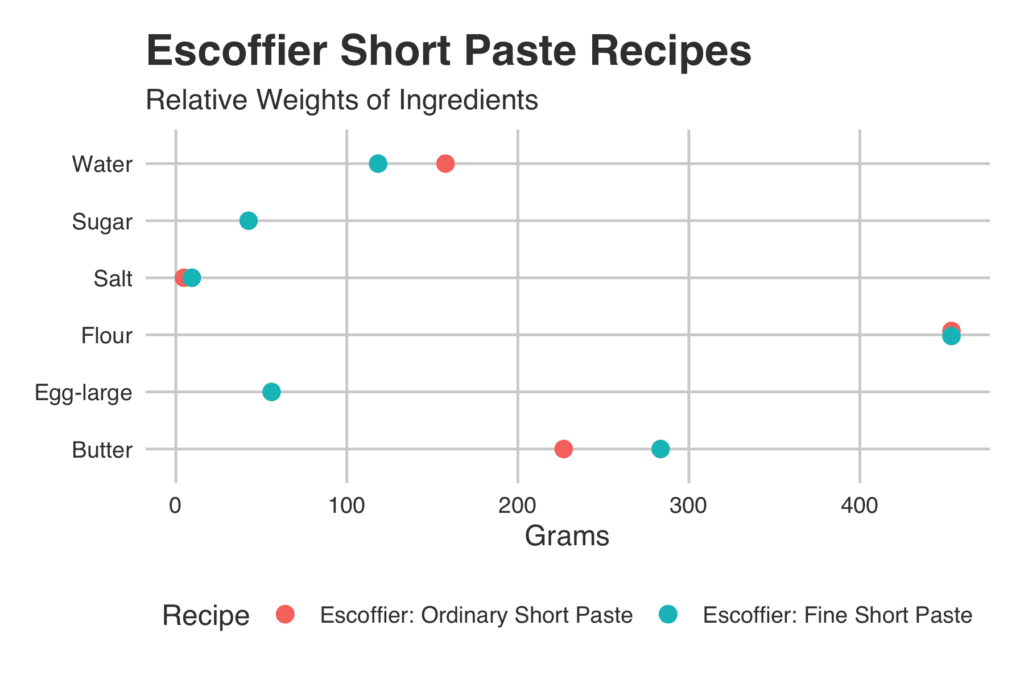
Takeaway
- The Fine Short Paste intended for a dessert pastry has the egg and sugar where the ordinary does not, furthermore it has more butter.
A Reference Tart from Dorie Greenspan
— Pretty close to perfection
In her book Around My French Table, Dorie Greenspan presents a Burgundian mustard tart that is a perfect example of a savory tart. (It is pictured above.) It is a good foundation for several variations of vegetable tarts. And importantly for us, the tart shell is flaky and delicious even though it has a tendency to become too crisp.
The tart calls for a 9-9.5″ tart pan and uses both the egg and sugar found in Escoffier’s Fine Short paste. To compare this tart shell, requiring 150g (1¼ cups) of flour, to the Escoffier recipes we will scale his recipes down to almost a third the size, so that all recipes use the same amount of flour. All other ingredients are scaled by the same ratios.
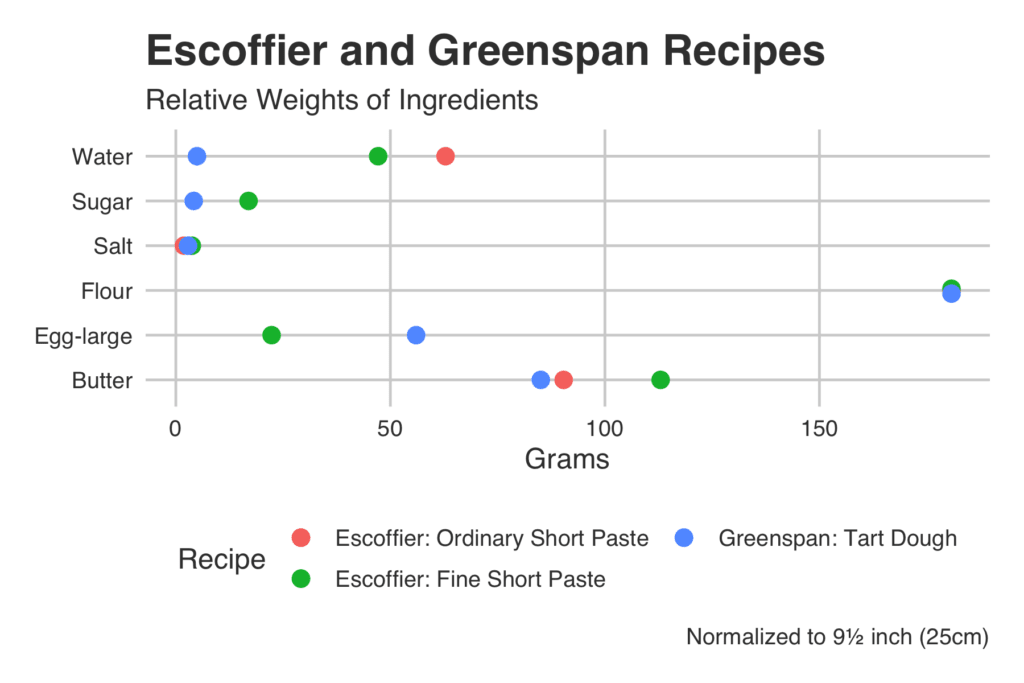
Takeaways
- Since both the Escoffier Fine Short and the Greenspan recipe call for one egg for a pound of flour, and Greenspan uses one for roughly a third of that amount, it has effectively more egg.
- The required butter of the Greenspan recipe is right between the two Escoffier recipes
Aaron Hyman’s Tart Shell
–– Different approach to a similar end
Promoted by Samin Nosrat as a perfect all-purpose crust, Aaron Hyman’s tart shell uses crème fraiche or plain cream. For taste reasons, I prefer the crème fraiche to the plain cream. A quick analysis will show that this tart shell is very similar. (Note: Nosrat lists the dough as Aaron’s Tart Dough, we will use that name in the following.)
The flour required for the pastry is scaled as before and all other ingredients likewise to produce a 9.5 inch tart shell.
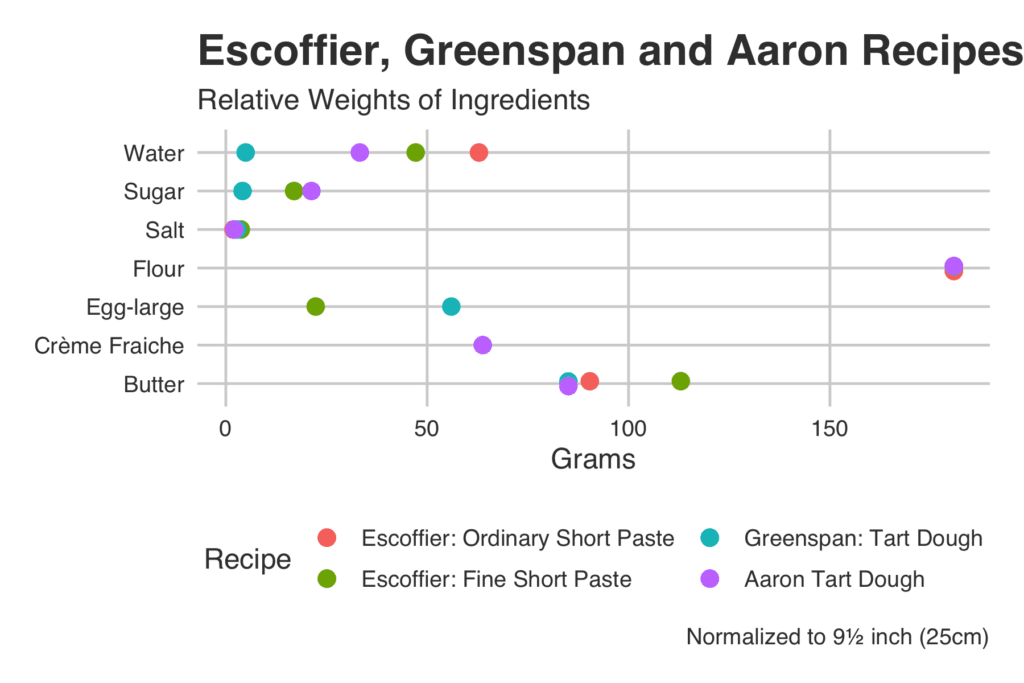
Takeaways
- Aaron’s alternate tart shell recipe has almost the same about of butter as the Greenspan reference shell.
- In reality the difference between the two recipes is that egg is being replaced with crème fraiche.
- The Aaron tart has the highest amount of sugar — dessert shell level.
Egg or Crème Fraiche?
What is the impact of replacing the egg with cream? Is it reasonable to consider that this proposed recipe is not much different. Or to be very specific; eggs, cream, and butter all introduce dairy fat and water to recipes along with a small amount of solids. So, if we estimate the dairy fat and the water in those three ingredients and compare what do we get?
The above graph is reproduced with the additional calculated total water and calculated dairy fat from all sources.
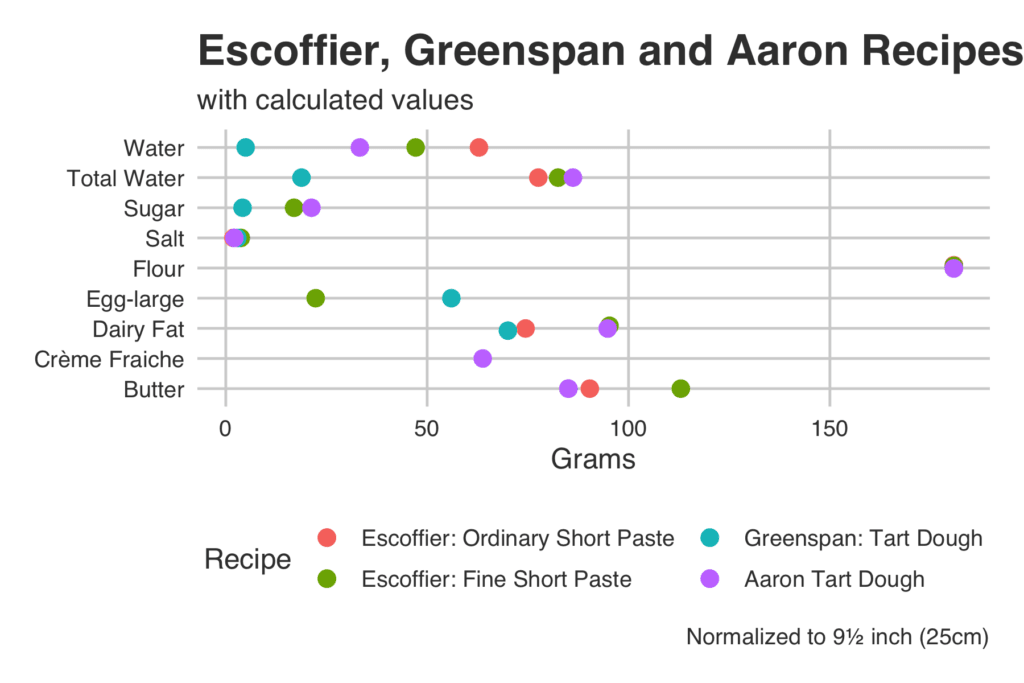
Takeaways
- As suspected accounting for the three sources of dairy fat, Aaron’s dough appears to be relatively close to the Escoffier: Fine Short Paste (the desert shell). Both have about 95g of dairy fat.
- Aaron’s dough is the sweetest of the three doughs that contain sugar.
In reality, it appears Aaron dough is pretty much a desert dough.
Conclusion — How do they taste?
How do they taste? Could either be used in place of each other? Although similar in makeup, the answer is a flat no. Simply, the taste of Aaron’s dough is not there to stand up to the strength of the mustard, leeks, and the eggs of the Mustard Tart pictured above. But it does have some promise.
Tasting results
- Aesthetically, the egg in the Greenspan tart gives a nice rich golden color, the taste richer. However, the egg gives a crispy almost burnt taste.
- In Aaron’s tart dough the crème fraiche gave a desirable tartness and a moister product. However, the richness in taste provided by the egg was missing.
While the two doughs are not interchangeable, it is possible the two together are even more desirable. Additionally, while hard if not impossible to scale a recipe with eggs (2/3 an egg for example), adding an appropriate amount of crème fraiche instead solves that problem.
Recommendation — Combine the two
The texture added by the crème fraiche really improves the taste and feel. While still flaky, we avoid the slightly burnt taste. However, the flavor of the egg is clearly missing. Therefore, the obvious answer is to combine the two. Furthermore based on the analysis above we can add eggs and crème fraiche in amounts to balance the fat and other components to whatever size we need. If we need a bigger tart shell we can work with the whole units of eggs and of course any measurement of crème fraiche we desire.
The perfect tart in two sizes
To produce two 9″ tart shells increasing the flour and the creme fraiche and proportionally. This gives a very similar result with still only one egg. For detailed hints please review this posting about the perfect savory tart.
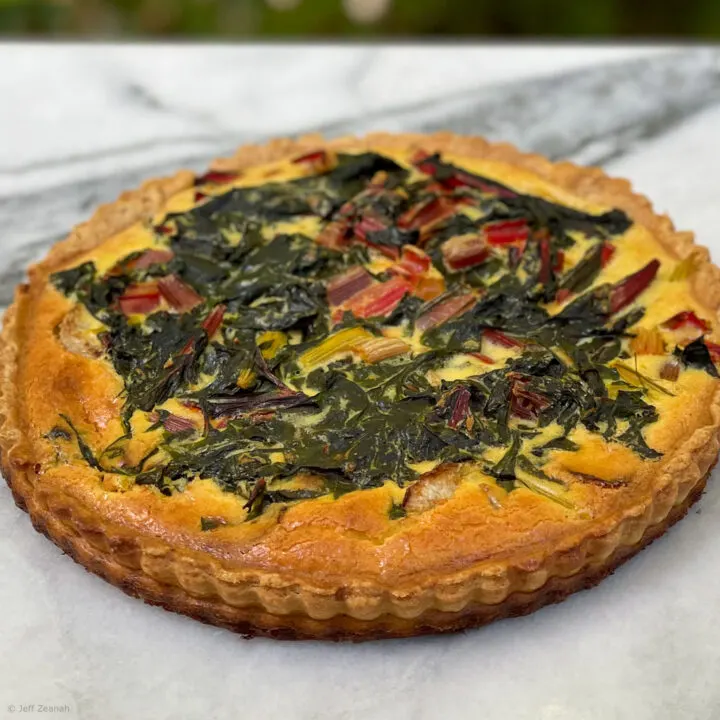
The Perfect Savory 9" (23cm) Tart
This dough will make two 9" (23cm) tart shells
Ingredients
- 360 g (3 cups) flour
- 25 g (scant 2 tablespoons) sugar
- 7 g (1 tablespoon) salt
- 170g (6 ounces or 12 Tablespoons) butter chilled and cut into about ½ inch (1 cm) cubes
- 1 large egg
- 65 g (ample ¼ cup) crème fraiche
- 30 ml (1 ounce) water
Instructions
To make the dough
- If using a mixer, chill the bowl, and paddle in the freezer for at least 20 minutes.
- Whisk the flour, sugar, and salt together.
- Assemble the mixer and bowl, and add dry ingredients. With the mixer on low, slowly add the cubes of butter. Mix for two or three minutes. The butter should be well cut into the dough. After all the pieces of butter are added, increase the speed slightly. Slivers of butter should remain visible. If some bigger chunks remain, work the bigger pieces of butter into the flour between your fingers.
- Beat the egg in with the creme fraiche and mix into the dough with the mixer still on low. The dough should start binding together. Add water if needed to improve texture.
- Turn out the dough onto a cutting board (or work surface). Using your hands, quickly work the dough together into one ball.
- Roll the dough into one or two discs, depending on your plans for use. Cover with wrap and refrigerate for at least two hours. If not using both immediately wrap it well and it will freeze well for at least two months.
To partially bake the shell
- Center a rack in the oven and preheat to 375°F.
- Roll out the dough on a floured surface or between two pieces of wax paper. The disc shape should start you on the way. Work quickly to keep dough cold while rolling not stretching. If working on a floured surface turn the dough with a quarter turn frequently to keep it from sticking.
- Place the dough inside the tart pan. Carefully push into corners without stretching. Trim excess dough from the edges and save it for another use. Prick the surface of the dough slightly with a fork to prevent air bubbles. Only 4 or 5 pricks should be needed. Coat the dough with foil or parchment paper. Fill with dried beans or pie weights.
- Bake for about 20 minutes until crust edges are lightly browned. (This assumes there will be approximately 30 minutes more baking after the tart is filled. Adjust as needed.)
Nutrition Information:
Yield: 8 Serving Size: 1 gramsAmount Per Serving: Calories: 370Total Fat: 22gSaturated Fat: 13gTrans Fat: 1gUnsaturated Fat: 7gCholesterol: 79mgSodium: 499mgCarbohydrates: 38gFiber: 1gSugar: 3gProtein: 6g
Calculated Nutrition is estimated.

The Perfect Savory Tart Shell 11" (28cm) version
Makes 2 11 (28cm) Shells
Ingredients
- 255 g (2 cups + 1 Tablespoon) Flour
- 20 g Sugar
- 5 g Salt
- 1 large egg
- 120g (4.25 ounces or 8.5 Tablespoons) butter chilled and cut into about ½ inch (1 cm) cubes
- 30 g crème fraiche
- 30 ml water, cold
Instructions
To make the dough
- If using a mixer, chill the bowl, paddle in the freezer for at least 20 minutes.
- Whisk the flour, sugar, and salt together.
- Assemble the mixer and bowl, add dry ingredients. With the mixer on low again, slowly add the cubes of butter. Mix for two or three minutes. The butter should be well cut into the dough. After all the pieces of butter or added, increase speed slightly. Slivers of butter should remain visible. If some bigger chunks remain, work the bigger pieces of butter into the flour between your fingers.
- Beat the egg in with the creme fraiche and mix into the dough with the mixer still on low. The dough should start binding together. Add water if needed to improve texture.
- Turn out the dough onto a cutting board (or work surface). Using your hands quickly work the dough together into one ball.
- Roll the dough into a disc. (Or 2 discs, if using for galettes ) Cover with wrap and refrigerate for at least two hours. If not using immediately wrap it well and it will freeze well for at least two months.
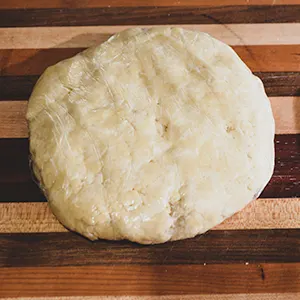
To partially bake shell
- Center a rack in the oven and preheat to 375°F.
- Roll out the dough on a floured surface or between two pieces of wax paper. The disc shape should start you on the way. Work quickly to keep dough cold while rolling not stretching. If working on a floured surface turn the dough with a quarter turn frequently to keep from sticking. With the paper lift and adjust to keep from sticking.
- Place the dough inside the tart pan. Carefully push into corners without stretching. Trim excess dough from edges and save it for another use. Prick the surface of the dough slightly with a fork to prevent air bubbles. Only 4 or 5 pricks should be needed. Coat the dough with foil or parchment paper. Fill with dried beans or pie weights.
- Bake for about 20 minutes until crust edges are lightly browned. (This assumes there will be approximately 30 minutes more baking after the tart is filled. Adjust as needed.)
Nutrition Information:
Yield: 8 Serving Size: 1 gramsAmount Per Serving: Calories: 270Total Fat: 16gSaturated Fat: 10gTrans Fat: 1gUnsaturated Fat: 5gCholesterol: 64mgSodium: 366mgCarbohydrates: 27gFiber: 1gSugar: 3gProtein: 4g

